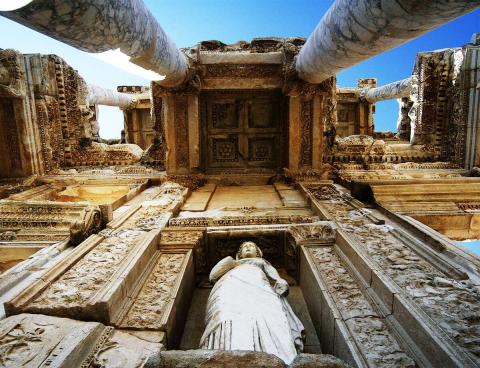Ephesus was an ancient port city whose well-preserved ruins are in modern-day Turkey. The city was once considered the most important Greek city and the most important trading center in the Mediterranean region. Throughout history, Ephesus survived multiple attacks and changed hands many times between conquerors. It was also a hotbed of early Christian evangelism and remains an important archaeological site and Christian pilgrimage destination.
Where Is Ephesus?
Ephesus is located near the western shores of modern-day Turkey, where the Aegean Sea meets the former estuary of the River Kaystros, about 80 kilometers south of Izmir, Turkey. According to legend, the Ionian prince Androclos founded Ephesus in the eleventh century B.C. The legend says that as Androclos searched for a new Greek settlement, he turned to the Delphi oracles for guidance. The oracles told him a boar and a fish would show him the new location. One day, as Androclos was frying fish over an open fire, a fish flopped out of the frying pan and landed in the nearby bushes. A spark ignited the bushes and a wild boar ran out. Recalling the oracles’ wisdom, Androclos built his new settlement where the bushes stood and called it Ephesus. Another legend says Ephesus was founded by the Amazons, a tribe of female warriors, and that the city was named after their queen, Ephesia.
Temple of Artemis
Much of Ephesus’s ancient history is unrecorded and sketchy. What is known is that in the seventh century B.C., Ephesus fell under the rule of the Lydian Kings and became a thriving city where men and women enjoyed equal opportunities. It was also the birthplace of the renowned philosopher Heraclitus. The Lydian King Croesus, who ruled from 560 B.C. to 547 B.C., was most famous for funding the rebuilding of the Temple of Artemis in Ephesus. Artemis was the goddess of the hunt, chastity, childbirth, wild animals and the wilderness. She was also one of the most revered Greek deities. Modern-day excavations have revealed that three smaller Artemis temples preceded the Croesus temple. In 356 B.C., a crazed man named Herostratus burned down the Temple of Artemis. The Ephesians rebuilt the temple even bigger. It was estimated to be four times larger than the Parthenon and became known as one of the Seven Wonders of the World. The temple was later destroyed and never rebuilt. Little remains of it today, although some of its remnants reside in the British Museum, including a column with Croesus’s signature.
Lysimachus
In 546 B.C., Ephesus fell to the Persian Empire, along with the rest of Anatolia. Ephesus continued to thrive even as other Ionian cities rebelled against Persian rule. In 334 B.C., Alexander the Great defeated the Persians and entered Ephesus. Upon his death in 323 B.C., one of his generals, Lysimachus, took over the city and renamed it Arsineia. Lysimachus moved Ephesus two miles away and built a new harbor and new defensive walls. The Ephesian people, however, wouldn’t relocate and remained in their homes until Lysimachus forced them to move. In 281 B.C., Lysimachus was killed at the Battle of Corupedium and the city was renamed Ephesus again. In 263 B.C., Ephesus fell under Egyptian rule along with much of the Seleucid Empire. The Seleucid king Antiochus III took back Ephesus in 196 B.C.; however, after being defeated at the Battle of Magnesia six years later, Ephesus fell under Pergamon rule.











